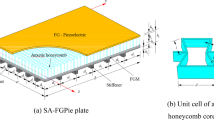Abstract
In this paper, we develop an accurate kinetostatic modeling method for bridge-type amplifiers by incorporating the impacts of nonlinear shear effect, center-shifting and load-stiffening. To account for the nonlinear stress-stiffening and shear effects, a Timoshenko Beam Constraint Model (TBCM) is first investigated to accurately predict the deformations of the short beam flexure hinges popularly employed in the bridge-type amplifiers. Accordingly, a flexible branched chain model is established for bridge-type amplifiers, where the input and output displacements, as well as the displacement amplification ratio and the input stiffness, are derived. The results indicate significant nonlinearities of the amplification ratio and the input stiffness with respect to the driving forces, which are further verified by the finite element analysis (FEA) results. The proposed modeling method can derive a more accurate model of the bridgetype amplification mechanism to capture its kinetostatic behaviors, which can better support the design and control of flexure mechanism based nano-manipulating systems.
Similar content being viewed by others
References
Yong, Y. K., Bhikkaji, B., and Moheimani, S. R. R., “Design, Modeling, and FPAA–Based Control of a High–Speed Atomic Force Microscope Nanopositioner,” IEEE/ASME Transactions on Mechatronics, Vol. 18, No. (3), pp. 1060–1071, 2013.
Park, D.-K., Lee, G.-I., Gao, J.-C., and Kim, J.-Y., “Research on the Design of the Ultra–High–Precision Positioning Control Error Compensation,” International Journal of Precision Engineering and Manufacturing, Vol. 17, No. (10), pp. 1351–1358, 2016.
Liu, P., Yan, P., Zhang, Z., and Özbay, H., “Robust Antiwindup Compensation for High–Precision Tracking of a Piezoelectric Nanostage,” IEEE Transactions on Industrial Electronics, Vol. 63, No. (10), pp. 6460–6470, 2016.
Huang, S.-C. and Dao, T.-P., “Design and Computational Optimization of a Flexure–Based XYPositioning Platform Using FEA–Based Response Surface Methodology,” International Journal of Precision Engineering and Manufacturing, Vol. 17, No. (8), pp. 1035–1048, 2016.
Choi, S. B., Han, S. S., Han, Y. M., and Thompson, B. S., “A Magnification Device for Precision Mechanisms Featuring Piezoactuators and Flexure Hinges: Design and Experimental Validation,” Mechanism and Machine Theory, Vol. 42, No. (9), pp. 1184–1198, 2007.
Liu, P.-B., Yan, P., Zhang, Z., and Leng, T.-T., “Flexure–Hinges Guided Nano–Stage for Precision Manipulations: Design, Modeling and Control,” International Journal of Precision Engineering and Manufacturing, Vol. 16, No. (11), pp. 2245–2254, 2015.
Na, T.-W., Choi, J.-H., Jung, J.-Y., Kim, H.-G., Han, J.-H., et al., “Compact Piezoelectric Tripod Manipulator Based on a Reverse Bridge–Type Amplification Mechanism,” Smart Materials and Structures, Vol. 25, No. 9, Paper No. 095028, 2016.
Liu, Y., Zhang, Y., and Xu, Q., “Design and Control of a Novel Compliant Constant–Force Gripper Based on Buckled Fixed–Guided Beams,” IEEE/ASME Transactions on Mechatronics, Vol. 22, No. (1), pp. 476–486, 2017.
Xu, W. and King, T., “Flexure Hinges for Piezoactuator Displacement Amplifiers: Flexibility, Accuracy, and Stress Considerations,” Precision Engineering, Vol. 19, No. (1), pp. 4–10, 1996.
Tian, Y., Shirinzadeh, B., Zhang, D., and Alici, G., “Development and Dynamic Modelling of a Flexure–Based Scott–Russell Mechanism for Nano–Manipulation,” Mechanical Systems and Signal Processing, Vol. 23, No. (3), pp. 957–978, 2009.
Lobontiu, N. and Garcia, E., “Analytical Model of Displacement Amplification and Stiffness Optimization for a Class of Flexure–Based Compliant Mechanisms,” Computers & Structures, Vol. 81, No. (32), pp. 2797–2810, 2003.
Ma, H.-W., Yao, S.-M., Wang, L.-Q., and Zhong, Z., “Analysis of the Displacement Amplification Ratio of Bridge–Type Flexure Hinge,” Sensors and Actuators A: Physical, Vol. 132, No. (2), pp. 730–736, 2006.
Xu, Q. and Li, Y., “Analytical Modeling, Optimization and Testing of a Compound Bridge–Type Compliant Displacement Amplifier,” Mechanism and Machine Theory, Vol. 46, No. (2), pp. 183–200, 2011.
Qi, K.-Q., Xiang, Y., Fang, C., Zhang, Y., and Yu, C.-S., “Analysis of the Displacement Amplification Ratio of Bridge–Type Mechanism,” Mechanism and Machine Theory, Vol. 87, pp. 45–56, 2015.
Ling, M., Cao, J., Zeng, M., Lin, J., and Inman, D. J., “Enhanced Mathematical Modeling of the Displacement Amplification Ratio for Piezoelectric Compliant Mechanisms,” Smart Materials and Structures, Vol. 25, No. 7, Paper No. 075022, 2016.
Liu, P. and Yan, P., “A New Model Analysis Approach for Bridge–Type Amplifiers Supporting Nano–Stage Design,” Mechanism and Machine Theory, Vol. 99, pp. 176–188, 2016.
Hao, G., and Li, H., “Extended Static Modeling and Analysis of Compliant Compound Parallelogram Mechanisms Considering the Initial Internal Axial Force,” Journal of Mechanisms and Robotics, Vol. 8, No. 4, Paper No. 041008, 2016.
Awtar, S., Slocum, A. H., and Sevincer, E., “Characteristics of Beam–Based Flexure Modules,” Journal of Mechanical Design, Vol. 129, No. (6), pp. 625–639, 2007.
Hao, G. and Hand, R. B., “Design and Static Testing of a Compact Distributed–Compliance Gripper Based on Flexure Motion,” Archives of Civil and Mechanical Engineering, Vol. 16, No. (4), pp. 708–716, 2016.
Chen, G. and Ma, F., “Kinetostatic Modeling of Fully Compliant Bistable Mechanisms Using Timoshenko Beam Constraint Model,” Journal of Mechanical Design, Vol. 137, No. 2, Paper No. 022301, 2015.
Cowper, G., “The Shear Coefficient in Timoshenko’s Beam Theory,” Journal of Applied Mechanics, Vol. 33, No. (2), pp. 335–340, 1966.
Hao, G., Li, H., Kemalcan, S., Chen, G., and Yu, J., “Understanding Coupled Factors that Affect the Modelling Accuracy of Typical Planar Compliant Mechanisms,” Frontiers of Mechanical Engineering, Vol. 11, No. (2), pp. 129–134, 2016.
Ma, F., Chen, G., and Hao, G., “Determining the Range of Allowable Axial Force for the Third–Order Beam Constraint Model,” Mechanical Sciences, Vol. 9, No. (1), pp. 71–79, 2018.
Hao, G., “Extended Nonlinear Analytical Models of Compliant Parallelogram Mechanisms: Third–Order Models,” Transactions of the Canadian Society for Mechanical Engineering, Vol. 39, No. (1), pp. 71–83, 2015.
Author information
Authors and Affiliations
Corresponding author
Rights and permissions
About this article
Cite this article
Liu, P., Yan, P. Kinetostatic Modeling of Bridge-Type Amplifiers Based on Timoshenko Beam Constraint Model. Int. J. Precis. Eng. Manuf. 19, 1339–1345 (2018). https://doi.org/10.1007/s12541-018-0158-0
Received:
Revised:
Accepted:
Published:
Issue Date:
DOI: https://doi.org/10.1007/s12541-018-0158-0




